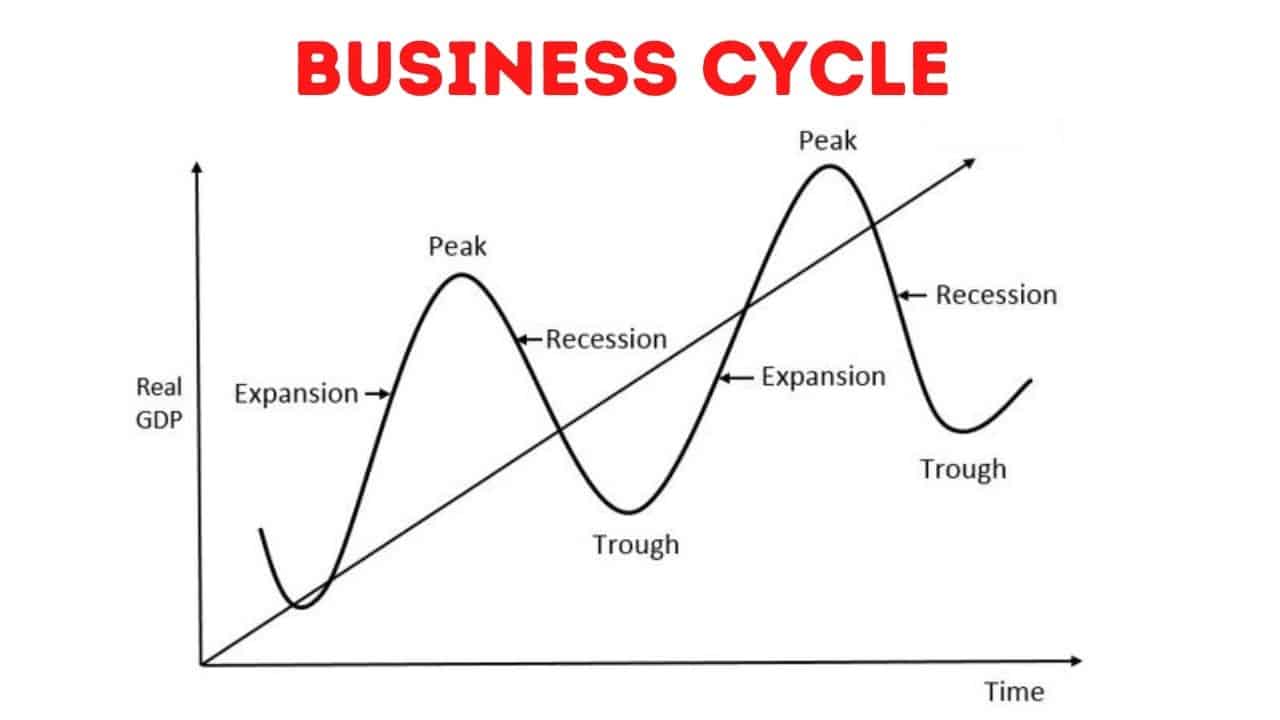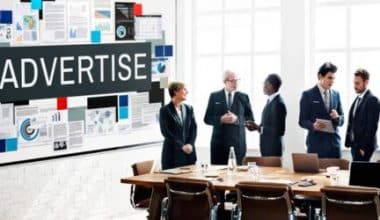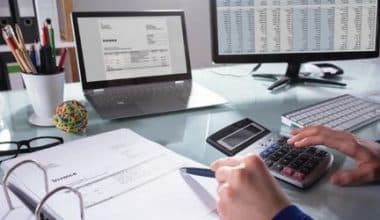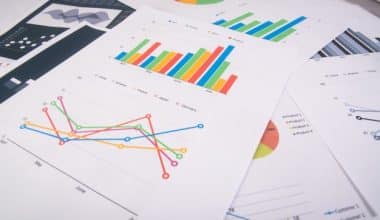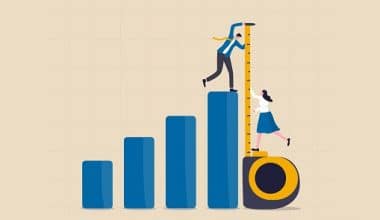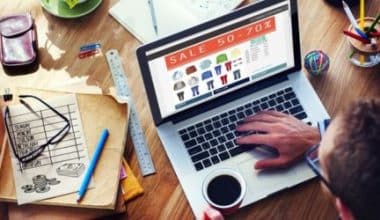We have different examples of cycles, ranging from Planetary cycles, Miscellaneous cycles, and of course, the Economic and Business cycle. In this article, we will be discussing in detail, everything you need to know about business cycles. Stay tuned!
What is Business Cycle?
A business cycle is a cycle of fluctuations in the gross domestic product (GDP) around its long-term natural growth rate.
From a conceptual point of view, the business cycle is the upward and downward movement of GDP (Gross Domestic Product) and refers to the time of expansions and contractions in the level of economic activity (trade fluctuations) around a growth trend of the long term.
Why is Business Cycle Important?
Understanding business cycles is critical to success while running a business. A business cycle, often known as a trade or economic cycle, is the measured expansion and contraction of economic growth over a given time period. Business owners can make informed judgments if they understand business cycles.
What Effect Does the Business Cycle Have on the Economy?
The business cycle model depicts how a country’s real GDP swings over time, passing through phases as aggregate output rises and falls. In a rising economy, the business cycle indicates a constant growth in potential output over time.
What is Another Name for Business Cycle?
- Variation,
- Trade Cycle
- Fluctuation.
Business Cycle Stages
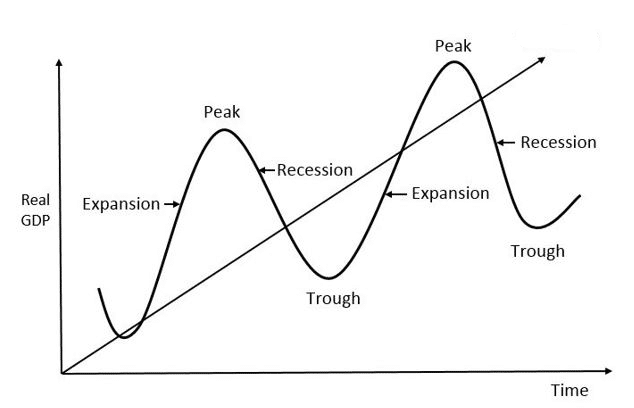
In the diagram above, the straight line is the constant growth line in the middle. The business cycle moves around the line. Below is a more detailed description of each phase of the business cycle:
#1. Expansion
The first phase of the business cycle is expansion. During this phase, positive economic indicators such as employment, income, production, wages, profits, demand and supply of goods and services increase. Debtors tend to pay their debts on time, the speed of the money supply is high, and investments are high. This process will continue as long as economic conditions are favorable for expansion.
#2. Peak
The economy then reaches a saturation point or climax, which is the second stage of the business cycle. The maximum growth limit is reached. Economic indicators have stopped growing and are at their highest level. Prices are at their peak. This phase marks the turning point in the trend of economic growth. Consumers tend to restructure their budgets at this point.
#3. Recession
The recession is the stage that follows the peak phase. The demand for goods and services begins to decline rapidly and steadily in this phase. Producers do not notice the drop in demand immediately and continue to produce, leading to an oversupply in the market. Prices tend to go down. As a result, all positive economic indicators, such as income, production, wages, etc., start to fall.
#4. Depression
Unemployment increases accordingly. Economic growth continues to decline, and since it is below the constant growth line, the stage is called depression.
#5. Trough
In the depression phase, the economic growth rate turns negative. There is a further decline until factor prices, as well as the demand and supply of goods and services, reach their lowest point. The economy finally bottomed out. It is the negative saturation point of an economy. National income and expenditures are largely depleted.
#6. Recovery
After this phase, the economy is in a recovery phase. At this point, the economy starts returning from the negative growth rate because the trend has changed. Demand starts to rise due to lower prices, and so does supply. The economy develops a positive attitude towards investment and employment and increases production.
Employment is starting to rise and due to accumulated cash balances with bankers, loans are also showing positive signs. In this phase, depreciated capital is replaced by producers, which leads to new investments in the production process.
The recovery will continue until the economy returns to sustained growth levels. Complete a full boom and bust business cycle. The extreme points are the high point and the low point.
Who Measures the Business Cycle?
The National Bureau of Economic Research figures out the phases of the business cycle by looking at the quarterly growth rates of GDP. Also, it looks at things like employment, real personal income, industrial production, and retail sales every month. Because analyzing this data takes time, the NBER will not notify you of the phase until it has begun. You can check the indicators to see where we are in the business cycle.
What are the Features of the Business Cycle?
The term “business cycle” refers to the cyclical pattern of economic boom (expansions) and bust (recessions). Recessions are characterized by falling output and employment; an “overheating” economy is characterized by unsustainable rapid economic expansion and rising inflation.
What is the Most Crucial Feature of the Business Cycle?
One of the most significant aspects of the business cycle is change. As a result, after some time, company operations begin to return. The swings continue, and the government’s actions reflect this.
What Factors Affect Business Cycle?
Business decisions, interest rates, consumer expectations, and external challenges are the primary contributors to fluctuations in the business cycle. When enterprises boost production, they increase aggregate supply and contribute to economic growth. When they reduce production, supply falls, and a contraction may occur.
Who Manages the Economic Cycle?
The government manages the business cycle. Lawmakers use fiscal policy to influence the economy. They use expansionary fiscal policies if they want to end a recession, and they should use contractionary fiscal policies to prevent the economy from overheating. However, this rarely happens because they are thrown out of office when taxes are raised, or popular shows are cut.
The central bank of the nation uses monetary policy. It cuts interest rates to end a contraction or bottom out (called an expansionary monetary policy). The central bank raises interest rates to manage an expansion so that it does not peak. That is a contractionary monetary policy
Causes of Business Cycles
Many factors contribute to the cyclical pattern of economic change. There are internal factors within the economy that can cause these changes. And there are also external factors that can lead to an economic boom or bust. Let’s take a look at all the causes of business cycles.
Internal Causes of Business Cycles
These endogenous factors can cause changes in the stages of the business and the economy in general. Let’s take a look at the internal causes of business cycles.
#1. Changes in demand
Keynesian economists believe that a change in demand causes a change in economic activity. When demand increases in an economy, companies produce more goods to meet the demand.
There is more production, employment, income, and profits. This will lead to an economic boom. However, excessive demand can also lead to inflation.
On the other hand, when demand falls, so does economic activity. This can lead to bankruptcy, which, if held for an extended period of time, can even lead to a downturn in the economy.
#2. Investment fluctuations
Fluctuations in investment, such as fluctuations in demand, are one of the main causes of business cycles. Investments will fluctuate based on many factors, such as the economy’s interest rate, business interests, profit expectations, etc.
An increase in investment will lead to an increase in economic activity and expansion. A decrease in investment has the opposite effect and can cause a bottom or even a depression. Apply Business ethics.
#3. Macroeconomic policy
A nation’s monetary and economic policies will also lead to changes in the phases of an economic cycle. So when monetary policy tries to expand economic activity by encouraging investment, the economy will skyrocket. On the other hand, if taxes or interest rates go up, the economy will slow down or go into recession.
#4. Money supply
There is another belief that business cycles are purely monetary phenomena. So changes in the money supply will cause business cycles. An increase in money on the market will lead to growth and expansion.
However, too much money can also cause adverse inflation. And the decrease in the money supply will cause a recession in the economy. Learn financial management!
External causes of Business Cycles
#1. Wars
In times of war and unrest, economic resources are used to make special goods such as weapons, weapons, and other similar war goods. The focus is shifting from consumer goods and capital goods. (frogbones.com) This will lead to a decrease in income, employment, and economic activity. Then the economy will experience a wartime recession.
And later, after the war, the focus will be on rebuilding. It is necessary to rebuild the infrastructure (houses, roads, bridges, etc.). This will help the economy recover if progress is made. Economic activity will increase as effective demand increases.
#2. Technological shocks
New and exciting technology is always a boom for business. New technologies mean new investments, more jobs, and, as a result, higher income and profits. For example, the invention of the modern cell phone was the reason for a huge boom in the telecommunications industry.
#3. Natural factors
Crops and the agricultural sector can be hurt by floods, droughts, hurricanes, etc. Food shortages will lead to higher prices and high inflation. Capital goods can also experience a decline in demand.
#4. Population growth
If population growth gets out of control, the economy could be a problem. Basically, the total savings of an economy decrease when population growth exceeds economic growth. The investment will also fall, and the economy will experience depression or slow down.
How Long is a Business Cycle?
The length of business cycles varies according to the state of the economy. The average duration of an expansion is slightly less than five years, and the average duration of a recession is 11 months. A total cycle length of five and a half years is typical.
The Impact of Supply and Demand on the Business Cycle
At first, the expansion occurs because customers are confident in the economy. They assume that their employment and income are secure. As a result, people spend more, which increases demand, which causes businesses to hire more workers and raise capital expenditures to meet that need. As investors allocate more capital to assets, stock values rise.
Overheating: The expansionary phase peaks when demand exceeds supply, and enterprises take on additional risks to meet rising demand and remain competitive.
Scaling back: An economy undergoes a contraction when interest rates rise too quickly, inflation rises too quickly, or a financial crisis develops. The confidence that fueled demand swiftly fades, to be replaced by declining consumer confidence. Individuals hoard money rather than spend it, cutting demand, while firms curtail output and lay off workers as sales fall. Investors sell stocks to avoid a decline in the value of their portfolios, which causes stock prices to fall further.
During the trough phase, demand and production are at their lowest levels. Needs, however, inevitably reassert themselves. Over time, consumers gain confidence as production and business activity get better, which is often because of what the government does and how it acts. They start buying and reinvesting, and the economy resumes its expansion phase.
Governments’ Impact on Business Cycles
The fact that business cycles move in natural phases does not preclude their influence. Countries can control the different stages by using monetary and fiscal policies to slow them down or speed them up. The government is in charge of fiscal policy, while the central bank is in charge of monetary policy.
When an economy is contracting, particularly in a recession, governments utilize the expansionary fiscal policy, which consists of increasing government spending or decreasing taxes. These actions enhance the disposable income available to consumers, encouraging economic growth.
Similarly, in a central bank, such as the Federal Reserve in the United States, an expansionary monetary policy will be used to terminate a contractionary period by lowering interest rates, making borrowing money cheaper, so increasing expenditure, and, eventually, the economy.
When an economy grows too quickly, the government will use a “contractionary monetary policy,” which includes cutting spending and raising taxes. This limits the disposable income available for spending, slowing down the economy. To use a contractionary monetary policy, the central bank will raise interest rates, making borrowing more expensive and, as a result, spending money less appealing.
In conclusion
Even though business cycles seem to only affect “the economy,” they affect people in the real world. Recognizing the present cycle might impact people and their lifestyle choices.
For example, while we are in a contraction phase, locating work is often more difficult. People may take jobs that aren’t the best to make ends meet and hope to get a better job when the economy improves.
To get a full understanding of the business cycle, you have to know what business is, the concepts and characteristics
Business Cycle FAQs
What business cycle are we currently in?
Mid-cycle period
The United States and other major economies are still in the middle of the business cycle, but an increasing number of signs indicate that the late cycle, when economic growth slows, is approaching.
What is depression phase in business cycle?
In economics, a depression is a major downturn in the business cycle marked by sharp and sustained declines in economic activity; high rates of unemployment, poverty, and homelessness; increased rates of personal and business bankruptcy; massive declines in stock markets; and significant reductions in international trade.
How does business cycle affect our economy?
The business cycle model depicts how a country’s real GDP swings over time, passing through phases as aggregate output rises and falls. In a rising economy, the business cycle indicates a constant growth in potential output over time.
What are the 5 phases of the business cycle?
The economy passes through phases in a business cycle such as expansion, peak economic growth, reversal, recession, and depression, eventually leading to a new cycle.
{
“@context”: “https://schema.org”,
“@type”: “FAQPage”,
“mainEntity”: [
{
“@type”: “Question”,
“name”: “What business cycle are we currently in?”,
“acceptedAnswer”: {
“@type”: “Answer”,
“text”: “
Mid-cycle period
The United States and other major economies are still in the middle of the business cycle, but an increasing number of signs indicate that the late cycle, when economic growth slows, is approaching.
“
}
}
, {
“@type”: “Question”,
“name”: “What is depression phase in business cycle?”,
“acceptedAnswer”: {
“@type”: “Answer”,
“text”: “
In economics, a depression is a major downturn in the business cycle marked by sharp and sustained declines in economic activity; high rates of unemployment, poverty, and homelessness; increased rates of personal and business bankruptcy; massive declines in stock markets; and significant reductions in international trade.
“
}
}
, {
“@type”: “Question”,
“name”: “How does business cycle affect our economy?”,
“acceptedAnswer”: {
“@type”: “Answer”,
“text”: “
The business cycle model depicts how a country’s real GDP swings over time, passing through phases as aggregate output rises and falls. In a rising economy, the business cycle indicates a constant growth in potential output over time.
“
}
}
, {
“@type”: “Question”,
“name”: “What are the 5 phases of the business cycle?”,
“acceptedAnswer”: {
“@type”: “Answer”,
“text”: “
The economy passes through phases in a business cycle such as expansion, peak economic growth, reversal, recession, and depression, eventually leading to a new cycle.
“
}
}
]
}
